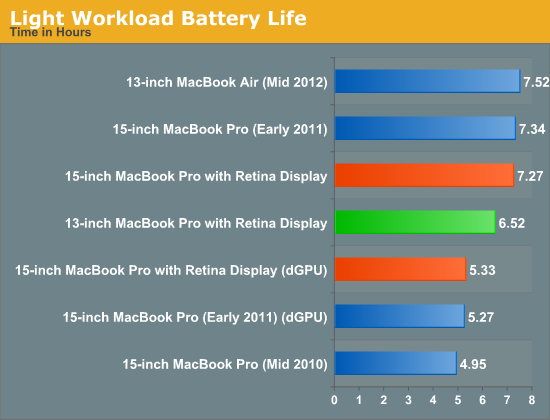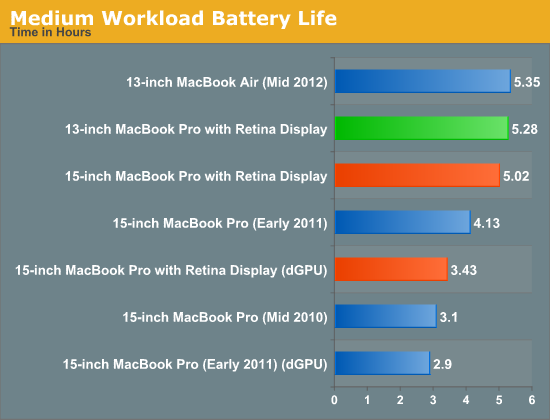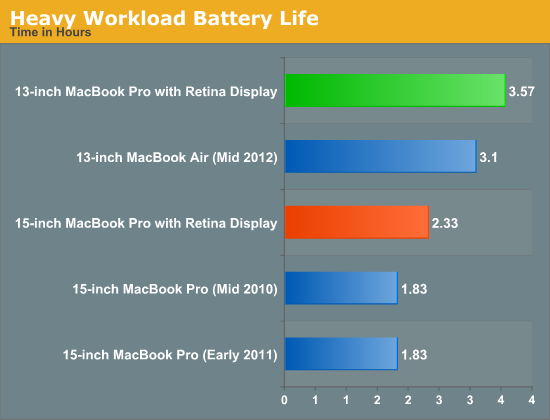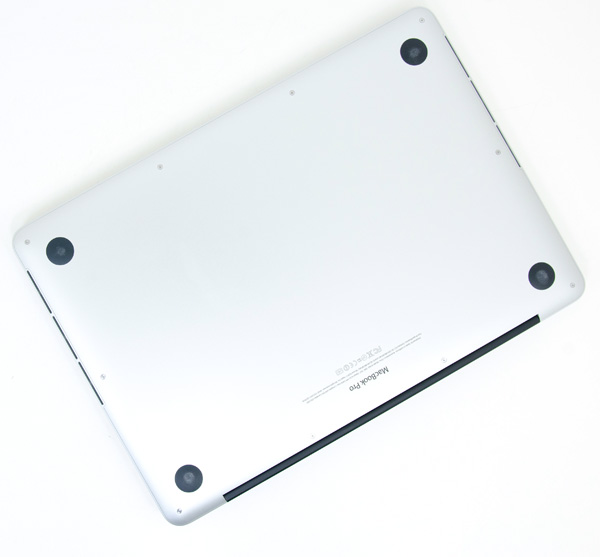13-inch Retina MacBook Pro Review (Late 2012)
by Anand Lal Shimpi on November 13, 2012 2:53 AM ESTBattery Life
The 13-inch rMBP features an integrated 74Wh, non-user-serviceable lithium polymer battery. The smaller chassis forced the use of a smaller battery compared to the 95Wh part used in the 15-inch rMBP. With a 22% reduction in battery capacity, the question is whether or not the drop in power consumption will keep battery life balanced between the two systems. CPU TDPs also go down by an identical 22% (45W down to 35W), but the comparison is more complex than that. The 15-inch rMBP has an on-board discrete GPU that, when active, can significantly impact battery life. Without the dGPU inside the system, the 13-inch rMBP does potentially have an advantage.
To quantify battery life, I turned to our updated OS X battery life suite that I introduced earlier this year. As always we have three individual tests, each simulating a different amount of load. All battery life tests were run with the display calibrated to 200 nits. The test descriptions are below:
The light and medium suites are inherently related - they use the same workload and simply vary the aggressiveness of that workload. The light test hits four different websites every minute, pausing for nearly the entire time to simulate reading time. Flash is enabled and present on three of the sites. The long pause time between page loads is what really makes this a light test. Web browsing may be the medium for the test but if all you're doing is typing, watching Twitter update and maybe lazily doing some other content consumption this is a good representation of the battery life you'll see. It's a great way of estimating battery life if you're going to be using your notebook as a glorified typewriter (likely a conservative estimate for that usage model).
The medium test hits the same webpages (Flash and all) but far more aggressively. Here there's less than 10 seconds of reading time before going onto the next page. It sounds like a small change but the impact on battery life is tremendous.
Both the light and medium tests are run in their default state with processor graphics enabled, as well as with the discrete GPU forced on. I run with the dGPU on as well because it's far too often that a single application open in the background will fire up the dGPU and contribute to draining your battery. The goal here is to deliver useful numbers after all.
The final test is very similar to our old heavy multitasking battery life tests, but with some updates. Here I'm downloading large files at a constant 1MB/s from a dedicated server, while playing back a looped 1080p H.264 movie (the Skyfall trailer) all while running the medium battery life test. The end result is a workload that gives you a good idea of what a heavy multitasking usage model will do in terms of battery life. I've found that OS X tends to fire up the dGPU anyway while running this workload so I saw no reason to run a separate set of numbers for processor and discrete graphics.

Our light workload doesn't do much to stress all four cores in the 15-inch rMBP, so that machine effectively behaves like a 13-inch rMBP with a bigger battery. The larger display (more pixels, more power hungry backlight) does consume a bit more power but the 15-inch rMBP manages to last 11% longer on a single charge compared to the 13-inch model. Turn the dGPU on however and the 13-inch rMBP easily outlasts its bigger brother.
Compare the 13-inch rMBP to the 13-inch MacBook Air and you see exactly why the Air isn't getting a Retina Display anytime soon. With only a 50Wh battery, the MacBook Air manages 15% better battery life than the 74Wh 13-inch rMBP. The MBA uses a much lower powered CPU, but I don't know how responsible that is for the difference in battery life here given the very light workload. If I had to guess, I'd say the reason for the difference here is the display and backlight power consumption. What may be more likely than a MacBook Air with Retina Display is some sort of MBA/Retina iPad convergence into some sort of a new device down the road.

Ratchet up the workload and the two rMBPs look very similar in battery life, with the 13-inch model holding onto a 5% advantage. The 13-inch MacBook Air also loses its battery life advantage here as well. Once again if you turn on the dGPU, the 15-inch rMBP blows through its battery much quicker.

In our heavy test the 13-inch rMBP sets a new record for our new suite, outlasting the 13-inch MBA by 15% (despite having a 48% larger battery). Worst case battery life is much better on the smaller rMBP compared to the 15-inch model thanks to its use of a dual-core processor with no discrete GPU. Performance obviously suffers, but if all you care about is battery life the 13-inch rMBP will do better on a single charge.











79 Comments
View All Comments
Spunjji - Tuesday, November 13, 2012 - link
As of a few days ago Adobe updated Lightroom to include Retina support in the Develop window. That means the UI will scale while the image remains at a 1 for 1 pixel mapping and is unaffected by scaling.piroroadkill - Tuesday, November 13, 2012 - link
In your chart noting the different screen ratios, you have Retina MacBook Pro under 16:9 - clearly incorrect, 2560x1600 and 2880x1800 for the 13 and 15 inch respectively are 8:5 ratios (16:10 in common terms).Beerfloat - Tuesday, November 13, 2012 - link
A MacBook Pro needs a GPU, period. Sure, performance of the Intel solution is getting stronger, and may soon reach parity on the low end. But more importantly, the mature driver and ecosystem that Nvidia brings will still be an advantage for some generations to come.This kind of corner cutting is almost acceptable in the Air. But not in a Pro.
Spunjji - Tuesday, November 13, 2012 - link
Agreed. Shame, but definitely a compromise too far.mayankleoboy1 - Tuesday, November 13, 2012 - link
" I definitely noticed the missing cores (and decrease in clock speed compared to the higher spec'd 15),"What are you doing that makes use of 4 real cores ? And is the 200mhz speed difference really noticable ?
I would say that in normal surfing+office apps, a SSD would make all the differences between CPU redundant...
jramskov - Tuesday, November 13, 2012 - link
Lightroom would be one answer.mayankleoboy1 - Tuesday, November 13, 2012 - link
But does Anand even use it ? Regularly ?tipoo - Friday, December 7, 2012 - link
Why would someone buy this for "surfing+office apps"? It's meant to be a machine for professionals and high end users, hence Pro.smurray - Tuesday, November 13, 2012 - link
What app is being used to measure the FPS of the UI during things like Safari scrolling? I currently have an 13" rMBP w/ the upgraded i7 CPU and am curious what my results would be compared to what was experienced in the review.Ryan Smith - Tuesday, November 13, 2012 - link
For instantaneous tests like Safari (where you see the speedometer-styled FPS indicator), we use Quartz Debug. For average framerates over a period of time we use the GL Injection Tool.